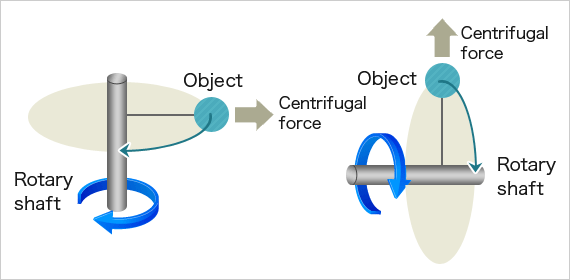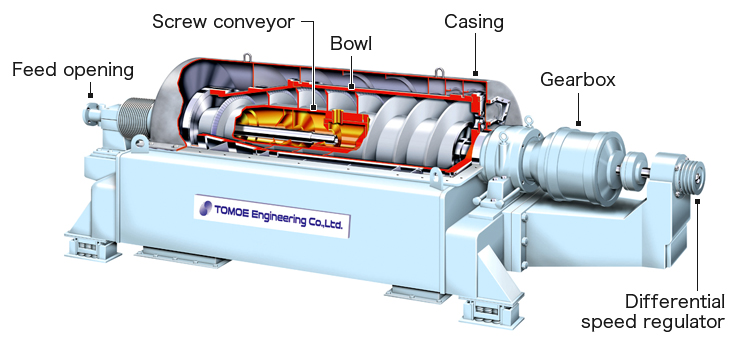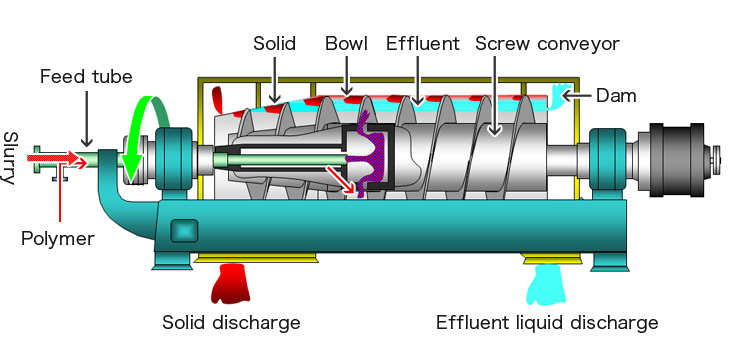What is centrifugal
separation?
- Machinery Equipment TOP
- What is centrifugal separation?
- Mechanism of centrifuge
Mechanism of centrifuge
What is centrifugal separation?
Centrifugal separation means separating substances with different specific gravities by means of centrifugal force.
Like water and oil, substances are separated through natural sedimentation if they have different specific gravities. However, it takes longer time to be settled because the sedimentation takes place under gravity of only 1 G. On the other hand, this substance can be settled and separated in shorter time with centrifugal force generated by rotation.
- Natural sedimentation

- Substances can be separated under gravity of only 1 G, but it takes longer time until solid with heavy specific gravity settled.
- Centrifugal sedimentation

- The same substances can be settled in shorter time by rotating it for applying centrifugal force.
Separating settled substance
Substances can be separated even by natural sedimentation if specific gravities are different.

| Name | Specific gravity | |
|---|---|---|
| Mother liquid | Water, solvent, etc. |
1 0.7~1.2 |
| Sediment | Solid | 0.8~7 |
Decanter centrifuges (Tomoe Engineering's main products) are designed for taking out the target substances with centrifugal force of one thousand to three thousands times higher than gravity to perform centrifugal separation forcibly. Owing to their separating ability of processing "very large scale"," within shorter time" and "continuously", decanter centrifuges are used for wide variety of applications, such as:
- Food (surimi, juices, seasonings, extracts)
- Chemistry (high-purity terephthalic acid, polyvinyl chloride, polypropylene, polyethylene)
- Environmental preservation (sewage, night soil), pharmaceuticals (antibiotics, medical fungus bodies)
- Energy (fuel oil, dehydrated plaster), recycling (industrial wastewater, waste plastics)
- Other (coal, tar, muddy water, abrasive, PCB, etc.)
Centrifugal force
Centrifugal force worked on object is determined by rotating distance from rotating center (radius of rotation) and rotating speed.

Centrifugal effect ≒ 895 / rN2
*r: Radius of rotation (m), N: rotating speed (min-1)
Familiar example
| Type | Centrifugal force | |
|---|---|---|
| 1 | Natural sedimentation | 1G |
| 2 | Rotating bucket filled with water | 2~3G |
| 3 | Cornering in F1 race | 3~5G |
| 4 | Jet fighter of making steep turn | 9G |
| 5 | Spin dryer of washing machine | 30~50G |
| 6 | Decanter centrifuge | 1,000~3,000G |
| 7 | Tubular centrifuge | 15,000~30,000G |
Bird's-eye view of the decanter type

Decanter's separating mechanism

- Both bowl and screw conveyor rotate concurrently and produce centrifugal force. (Speed of screw conveyor is slightly slower)
- Slurry is supplied from feed tube.
- Polymer is added, if necessary.
- Slurry is separated to solid and liquid in bowl.
- Solid is conveyed by screw conveyor to the left side of above figure for dewatering and discharge.
- Effluent overflows from dam shown on the right side of above figure for outflow.
